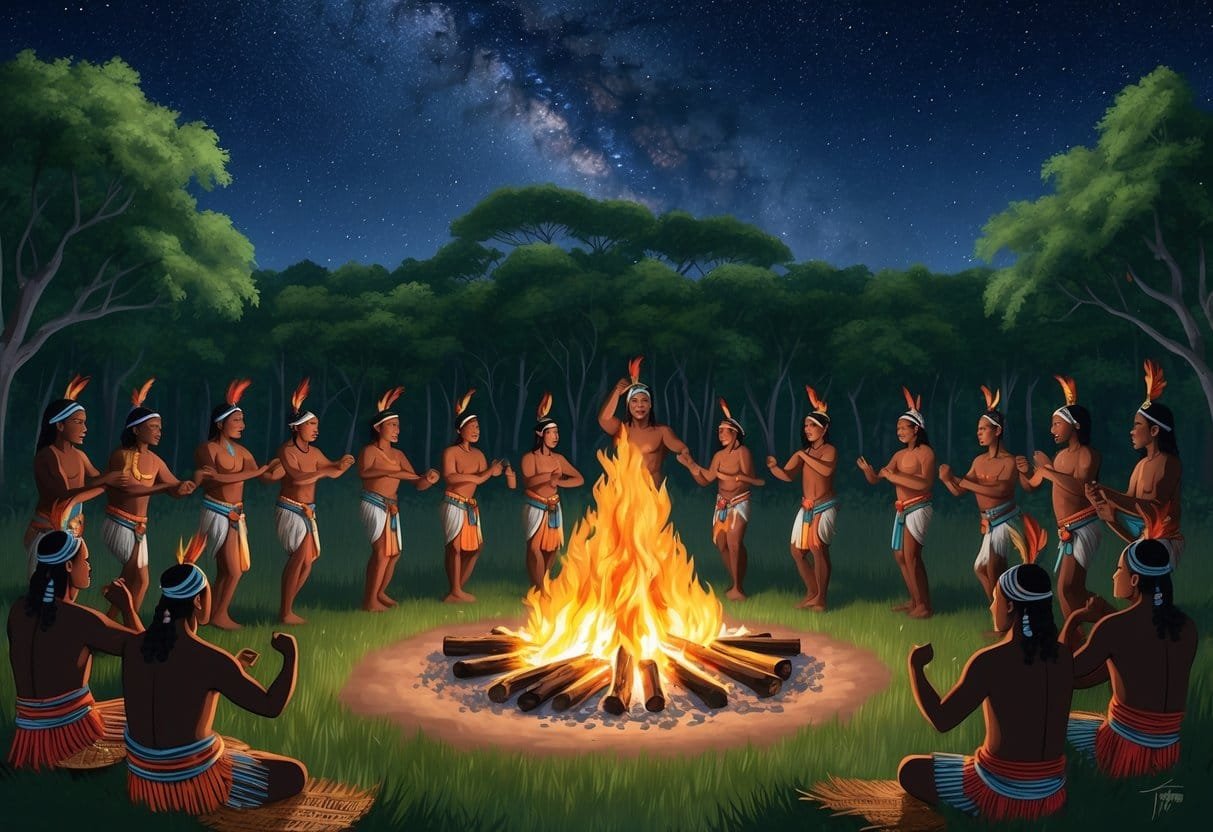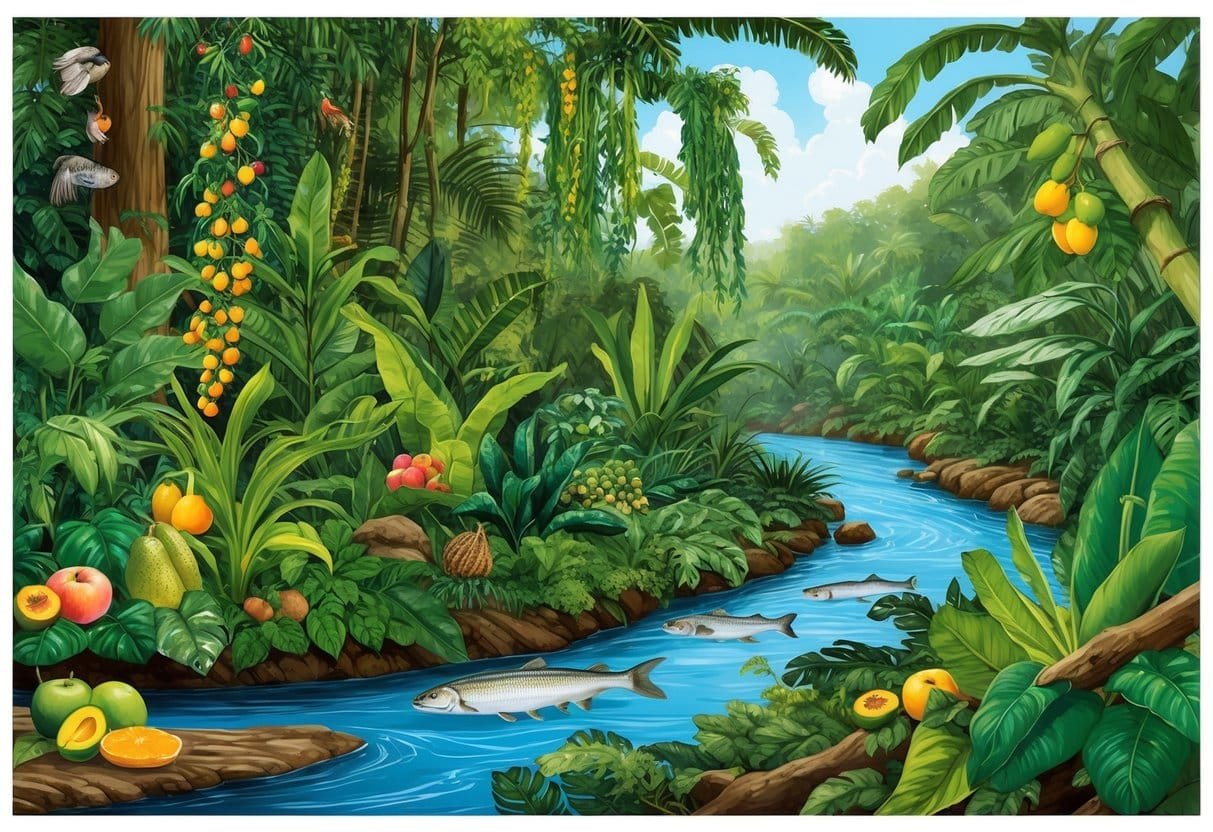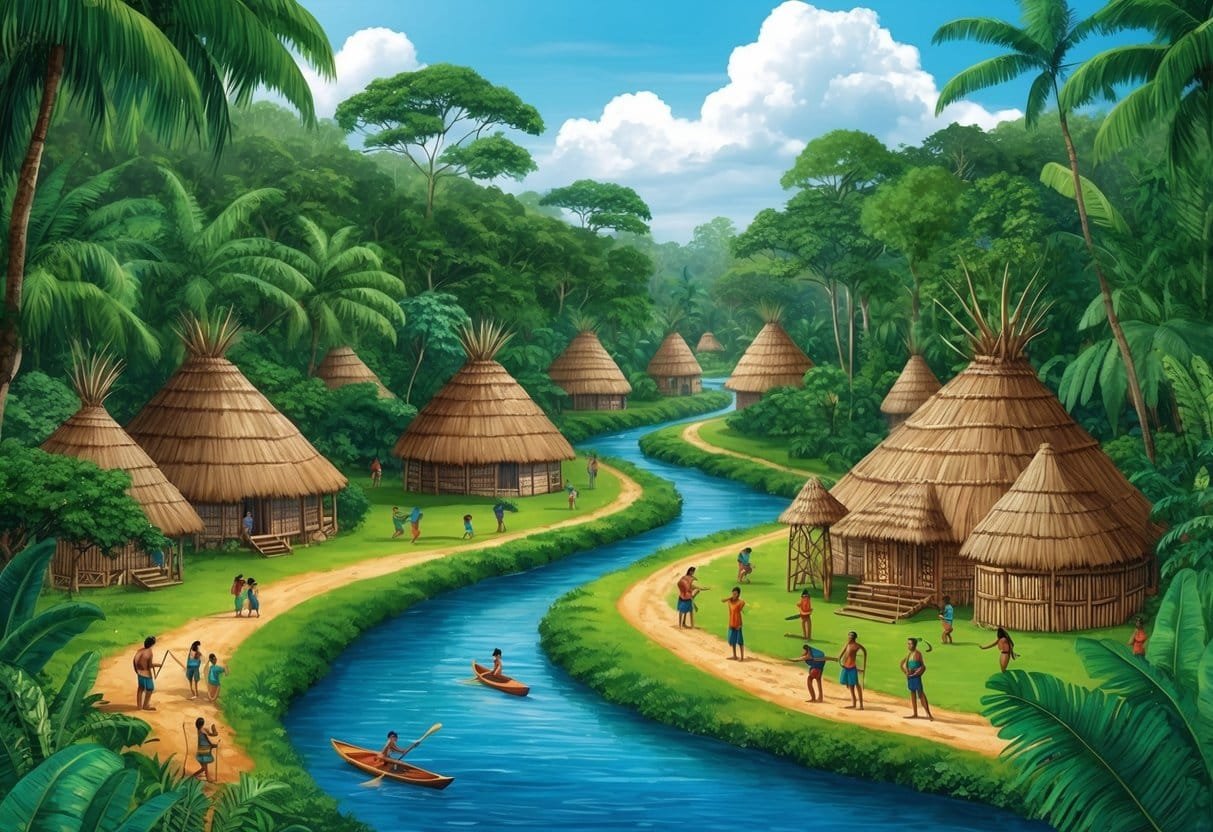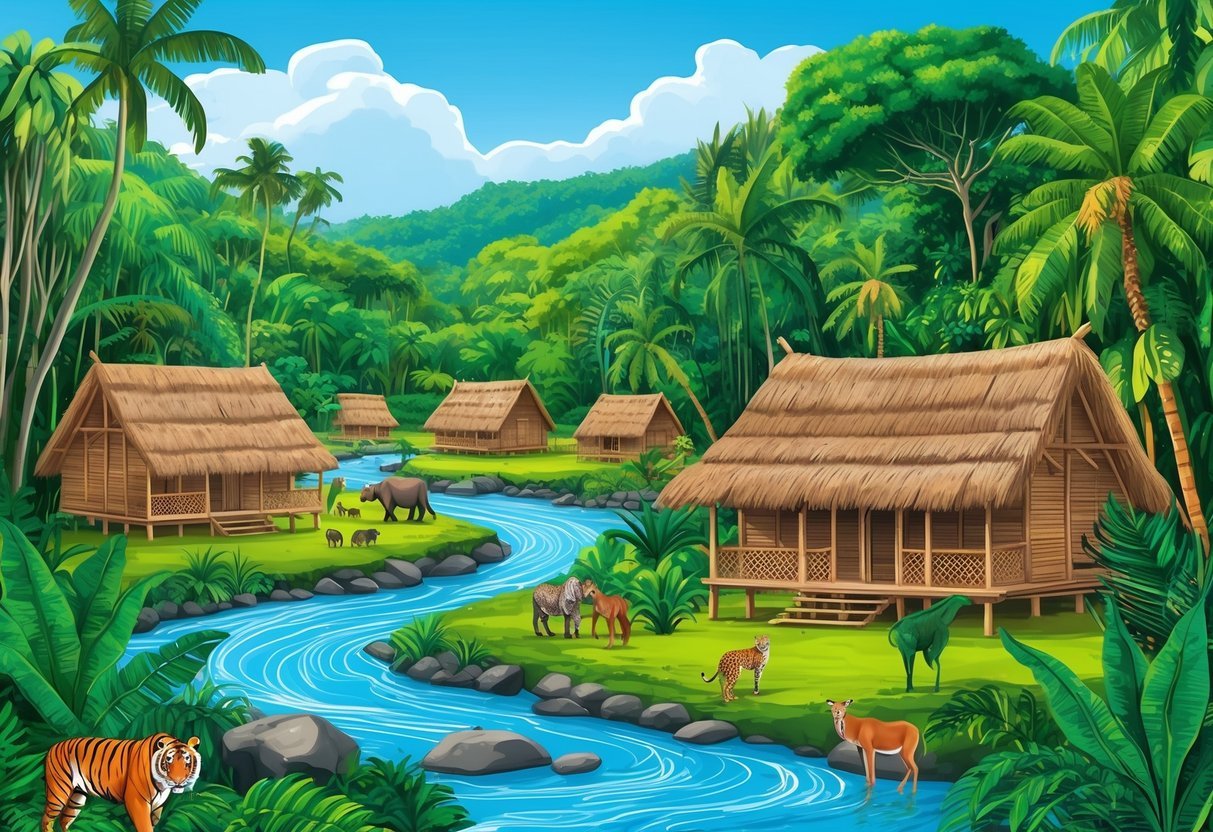The Amazon rainforest is home to many indigenous peoples who have lived there for thousands of years. These tribes have a deep bond with the forest and know its secrets well. They use plants for food and medicine, and they respect nature.
Over 350 different Amazon tribes exist, each with its own unique culture and way of life. Some groups still live in the deep jungle, away from modern society. Others have contact with cities but keep their traditions alive.
Amazon tribes face big problems today. The forest is being cut down for farms and mines. This hurts the land they depend on. Many people are working to protect these tribes and their home in the rainforest. Learning about Amazon tribes helps us see why the forest is so important.
Historical Context
The Amazon rainforest has a rich and complex history. Indigenous groups have called this region home for thousands of years. Their lives changed greatly when Europeans arrived in the Americas.
Pre-Colonial Times
The Amazon was home to many indigenous groups long before Europeans came. These groups had their own cultures and ways of life. They lived in the forest for at least 11,000 years.
Indigenous people shaped the Amazon in important ways. They planted useful trees and made the soil better for farming. This helped create the diverse forest we see today.
Different tribes lived throughout the Amazon. Some of the main groups were:
- Jês
- Tukano
- Panoan
These groups had unique languages, customs, and beliefs. They passed their knowledge down through generations.
Colonial Impact
When Europeans arrived in the 1500s, life changed for Amazon tribes. The Portuguese and Spanish came looking for gold and other riches.
Many indigenous people died from new diseases brought by Europeans. Others were forced to work as slaves. Some tribes moved deeper into the forest to avoid contact.
European colonizers tried to convert indigenous people to Christianity. This affected tribal beliefs and customs. The Amazon’s resources, like rubber trees, became important for trade.
Modern Influences
Today, Amazon tribes face new challenges. Logging, mining, and farming threaten their land and way of life. Some groups have lost their languages and traditions.
But many tribes are fighting to protect their rights and culture. They use modern technology to share their stories with the world. Some work with scientists to study the forest.
Governments now recognize some indigenous land rights. This helps tribes protect their homes. Many young indigenous people mix traditional ways with modern life.
Geographical Distribution
The Amazon rainforest spans multiple countries and contains diverse tribal territories. National borders impact indigenous groups in complex ways.
Tribal Territories
Isolated indigenous villages are found mainly in the headwaters of the Amazon Basin. These remote areas offer refuge from outside contact.
Brazil has the largest number of uncontacted tribes. Peru also has several groups living in voluntary isolation.
The state of Acre in western Brazil is home to many indigenous territories. These lands help protect tribal ways of life.
Manú National Park in Peru shelters some of the most isolated Amazonian peoples. The park’s vast forests allow tribes to maintain traditional lifestyles.
Some groups move between different areas of the rainforest. They follow food sources and avoid threats.
Impact of Borders
National borders often cut through tribal lands. This can separate communities and limit movement.
In some cases, borders provide protection. They may keep out loggers or miners from neighboring countries.
But borders can also bring problems. They may block access to traditional hunting or gathering grounds.
Some tribes live in border regions to avoid contact with national societies. These areas are often less developed.
Cooperation between countries is key for protecting cross-border indigenous lands. Joint patrols and shared policies can help.
Border conflicts sometimes force tribes to relocate. This can disrupt their connection to ancestral territories.
Societal Organization

Amazon tribes have unique social structures that shape their daily lives. Family ties and community bonds play a crucial role, while leadership roles help guide the group.
Family and Community
Indigenous people in the Amazon live in close-knit communities. Extended families often share a maloca, a large communal house. These structures can hold up to 100 people!
Kids learn important skills from their parents and elders. Boys might practice hunting, while girls help with farming and cooking. Everyone works together to support the tribe.
Sharing is a big deal in these communities. When someone goes hunting, they split the catch with others. This helps make sure everyone has enough to eat.
Leadership and Roles
Tribal chiefs or elders usually lead Amazon communities. These leaders help solve problems and make big decisions. They’re picked because they’re wise and respected.
Some tribes have shamans too. These special people know about healing plants and spiritual matters. They help keep the tribe healthy and connected to their traditions.
Women in Amazon tribes often have important roles. They might be in charge of farming or making crafts. In some tribes, women can even become leaders.
Everyone in the tribe has a job to do. Some are hunters, others are farmers. Working together helps the tribe survive and keep their way of life going strong.
Cultural Traditions

Amazon tribes have rich cultural practices that have been passed down for generations. Their traditions reflect a deep connection to nature and community.
Art and Craftsmanship
Indigenous cultures in the Amazon create beautiful art and crafts. They make intricate baskets, pottery, and jewelry using natural materials from the rainforest.
Body paint is an important art form. Tribes use colorful dyes from plants to decorate their skin for special events. Each design has a special meaning.
Many groups weave hammocks and bags from plant fibers. These items are both useful and artistic. Featherwork is another beloved craft, with headdresses and decorations made from colorful bird feathers.
Festivals and Ceremonies
Amazon tribes celebrate many festivals throughout the year. These events strengthen community bonds and honor nature spirits.
Rituals often take place in a maloca, a large communal house. Here, tribe members gather to sing, dance, and share traditional foods like manioc.
Coming-of-age ceremonies are important for young people. Boys and girls learn key skills and tribal knowledge as they become adults.
Harvest festivals thank the earth for its bounty. Tribes perform special dances and prepare feast foods. Some groups have ceremonies to honor the spirits of animals they hunt.
Contact with Outsiders
Contact between Amazon tribes and outsiders can be risky. It often leads to disease outbreaks and cultural clashes. Some tribes want to stay isolated, while others seek help.
Initial Encounters
Uncontacted tribes in the Amazon face many dangers when meeting outsiders. Disease is a big problem. Their immune systems aren’t ready for new germs. This can cause many deaths.
Some encounters happen by accident. Loggers or miners might stumble upon a tribe. Other times, the tribes reach out first. In 2014, a group of Indians made contact in Brazil. They were fleeing violence from drug traffickers.
FUNAI, Brazil’s Indian affairs department, tries to protect these tribes. They set up buffer zones around tribal lands. But it’s hard to keep all intruders out.
Recent Developments
Jair Candor is a expert who tracks Amazon tribes. He doesn’t meet them directly. Instead, he looks for signs they exist. This helps protect their land rights.
Some tribes now use modern items like metal tools. They might trade for these with nearby communities. But this can lead to dependence on outside goods.
Climate change and deforestation are new threats. They push some isolated groups out of their territories. This forces more contact with the outside world.
Governments and NGOs debate the best way to handle contact. Some say leave tribes alone. Others think careful, controlled contact is better. It’s a tough balance between respect and protection.
Threats to Survival
Amazon tribes face many dangers that put their way of life at risk. These threats come from both nature and people.
Environmental Challenges
Climate change is a big problem for Amazon tribes. It causes more droughts and wildfires. These fires can destroy the forest where tribes live and hunt.
Droughts make it harder to grow food and find clean water. Animals that tribes hunt may move away or die off.
Rising temperatures also bring new diseases to the area. Tribes may not have ways to fight these illnesses.
Human Incursions
People from outside pose serious risks to Amazon tribes. Logging companies cut down trees the tribes need to live. This destroys their homes and hunting grounds.
Mining for gold and other metals pollutes rivers. It makes water unsafe to drink or fish from.
Drug traffickers sometimes use tribal lands to grow crops or move drugs. This can lead to violence against tribe members.
Illegal logging is a big issue too. It often comes with roads that bring even more outsiders to tribal areas.
These human activities shrink the land tribes can use to live their traditional ways.
Conservation and Protection
Amazon tribes play a crucial role in safeguarding the rainforest. Their efforts, combined with outside support, help protect biodiversity and preserve traditional ways of life.
Local Initiatives
Indigenous communities actively protect their lands through various methods. They use traditional knowledge to manage resources sustainably. Many tribes create buffer zones around their territories to prevent encroachment.
Some groups use modern technology to monitor their forests. Drones and GPS help them spot illegal activities. Tribes also work with local authorities to enforce environmental laws.
Education is key. Elders teach younger generations about conservation. This helps keep traditional practices alive.
International Efforts
Global organizations support Amazon tribes in their fight to protect the rainforest. They provide legal aid to secure land rights. This helps tribes defend against illegal logging and mining.
Scientific partnerships boost conservation efforts. Researchers work with tribes to study biodiversity. This data helps create better protection plans.
International pressure on the Brazilian government has increased. Many countries push for stronger legal protection of the Amazon. This includes recognizing tribal land rights.
Funding from abroad supports sustainable development projects. These help tribes protect their lands while improving their lives.
Life in Amazon Tribes Today
Amazon tribes face challenges as they blend old and new ways of life. They work to keep their culture while adapting to the modern world.
Adaptation to Modernity
Many Amazon tribes now use modern tools like phones and motors. They mix these with their old ways.
Some tribes trade with nearby towns. They sell crafts or forest goods.
Tribal kids often go to school now. They learn to read and write. This helps them talk to the outside world. But it can also change their old ways.
Some tribes use solar panels for power. They watch TV and use the internet. This brings new ideas to their villages.
Health care is getting better for many tribes. They now have clinics and medicines. This helps them live longer and healthier lives.
Cultural Preservation
Tribes work hard to keep their old ways alive. They teach kids their languages and stories. Many still hunt and fish like their ancestors did.
Some tribes resist outside contact to protect their culture. They live deep in the forest, away from cities. These groups keep their old life mostly unchanged.
Tribal leaders fight for their land rights. They want to protect the forest they live in. This helps them keep their way of life.
Many tribes still use plants for medicine. They pass this knowledge down to younger members. This keeps their healing traditions alive.
Festivals and rituals are still very important. Tribes gather to dance, sing, and tell stories. These events keep their community strong.
Economy and Livelihood
Amazon tribes have unique ways of making a living. They use the forest’s resources and grow their own food. Their methods are old but work well with nature.
Agricultural Practices
Amazon tribes farm in smart ways. They use a method called slash-and-burn. This means they clear small areas of forest and plant crops.
They grow many types of food. Cassava is very important. They also plant corn, beans, and fruits. Some tribes grow cotton for clothes.
These farms are small but give enough food. After a few years, they let the land rest. The forest grows back, and they move to a new spot.
Many tribes also have home gardens. These are close to their houses. They grow herbs and medicines here.
Natural Resources Use
Tribes in the Amazon use the forest in many ways. Hunting and fishing are big parts of their life. They catch animals like monkeys, birds, and fish.
They gather fruits and nuts from the forest. Some collect honey from wild bees. These foods add to what they grow.
Many tribes make things to use and trade. They weave baskets and make pottery. Some create beautiful feather art.
Some tribes now work with outsiders to sell forest products. This includes things like Brazil nuts and natural oils.
They try to use resources without hurting the forest. This helps them live well while keeping their home healthy.
Diet and Subsistence

Amazon tribes rely on a mix of hunting, fishing, gathering, and farming for food. Their diets are high in carbs and low in fat, with most calories coming from plants.
Traditional Diets
The Tsimané people of Bolivia eat mostly plant-based foods. Manioc, also called cassava, is a key staple. They grow it in small farms and process it to remove toxins. Bananas and other fruits are also important.
Fish is their main protein. They catch many types from rivers and streams. Hunting adds some meat to their diet. They target animals like wild pigs and monkeys.
Palm trees give them both food and materials. They eat palm fruits and hearts. The leaves are used for roofs and baskets.
Their diet is linked to good health. Studies show the Tsimané have very healthy hearts.
Agricultural Methods
Amazon tribes use smart farming methods. They clear small areas in the forest to make gardens. These are called “slash-and-burn” farms.
Manioc is their main crop. It grows well in poor soil. They also plant bananas, corn, and other vegetables.
Crop rotation keeps the soil healthy. They move to new areas every few years. This lets old farms regrow into forest.
Some tribes use clever tricks. They add charcoal to the soil to make it better. This helps crops grow and keeps carbon in the ground.
Foraging is still important. They gather fruits, nuts, and plants from the forest. This adds variety to their diet.
Challenges and Opportunities

Amazon tribes face tough issues but also have chances to grow. They deal with big changes while trying to keep their way of life.
Education and Literacy
Amazon Indigenous peoples often struggle to get good schooling. Many tribes live far from cities, making it hard to reach schools.
Some groups are working to fix this. They’re setting up schools in tribal areas. These schools teach both basic skills and tribal knowledge.
Learning to read and write in their own languages is key. It helps tribes keep their culture alive. At the same time, they learn the country’s main language. This helps them talk to others outside their group.
Young people who get an education can become tribal leaders. They can speak up for their people’s rights. This gives tribes more power to shape their future.
Health and Well-being
Tribes in the Amazon often don’t have good health care. They may live far from hospitals. This makes it hard to get help when they’re sick.
Some groups are training tribal members as health workers. These people can give basic care right in the village. They also teach about staying healthy.
Clean water is a big issue. Many tribes don’t have safe water to drink. This can make people very sick. Some groups are working to fix this problem.
Keeping traditional medicine is important too. Tribes know a lot about healing plants. This knowledge can help everyone, not just their own people.

